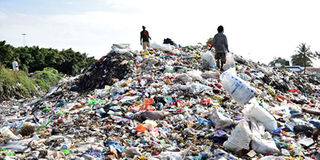African cities to drown in heaps of garbage in near future

A dumpsite in Mombasa. Global waste is expected to grow to 3.40 billion tonnes by 2050. PHOTO | FILE | NATION MEDIA GROUP
What you need to know:
- About 69 percent of waste is openly dumped, although use of landfills and recycling systems is becoming more prevalent.
- The world generates 2.01 billion tonnes of municipal solid waste annually, with at least 33 percent of that not managed in an environmentally safe manner.
LONDON
African cities face huge problems with collecting waste in the near future with Nairobi currently only collecting around 50 percent of all household rubbish, according to a new World Bank report.
The report — titled ‘What a waste’ — also says that either local or government authorities collecting waste in Sub-Saharan Africa do little about recycling, with Kenya’s programme of banning plastic bags proving to be a rare exception to the rule. Most recycling is done by the informal sector, the report says.
With Sub-Saharan Africa set to become the fastest area for waste growth in the world over the next 40 years, the problem needs urgent resolution, the report says.
At present more than half of waste is currently openly dumped, while in Europe, Central Asia and North America, around 90 percent of waste is collected.
The report says that Sub-Saharan Africa generated 174 million tonnes of waste in 2016, at a rate of 0.46 kilogramme per capita per day.
LANDFILLS
It is the fastest growing region worldwide, with waste expected to nearly triple by 2050.
The report says that waste in Sub-Saharan Africa is primarily organic, with 40 percent of it being food and green waste.
Overall, waste collection rates across the region under study are about 44 percent, although the rate is much higher in urban areas than in rural areas, where waste collection services are minimal.
About 69 percent of waste is openly dumped, although use of landfills and recycling systems is becoming more prevalent.
The World Bank says the issue of waste collection in Africa is critical as more than half of the world’s population growth is anticipated to occur in Sub-Saharan Africa by 2050.
“With waste generation expected to more than quadruple by 2050, it is alarming that waste is predominantly openly dumped,” the report says.
RECYCLING
However, waste management systems are slowly improving as cities are more frequently prioritising the construction of landfills, closure of dumps, and formalisation of collection systems to improve the environmental and health impacts of waste.
The best city for waste collection in Sub-Saharan Africa is Harare with Nairobi’s waste collection at around 50 percent of households compared to 65 percent in Kampala and 49 percent in Dar es Salaam.
The worst city for waste collection in Africa is Lagos, at only 10 percent.
The report also acknowledges that efforts are being made to improve recycling systems to divert waste from dumps and final disposal sites and to increase employment for informal waste collection workers.
POPULATION
The report also says that “population growth in Sub-Saharan Africa, amid high poverty rates, makes waste service fee collection and financing of the overall system key challenges for the region.
“Because governments have limited resources, waste often becomes a lower priority sector.”
At present because of moderate formal collection rates, open dumping and burning are commonly used to get rid of most household waste.
“Urban waste management is expensive. Waste management can be the single highest budget item for many local administrations in low-income countries, where it comprises nearly 20 percent of municipal budgets, on average.”
The world generates 2.01 billion tonnes of municipal solid waste annually, with at least 33 percent of that not managed in an environmentally safe manner.
Global waste is expected to grow to 3.40 billion tonnes by 2050. The report says that plastics are the biggest problem.
“If not collected and managed properly, they will contaminate and affect waterways and ecosystems for hundreds, if not thousands, of years. In 2016, the world generated 242 million tonnes of plastic waste, or 12 percent of all solid waste.”





